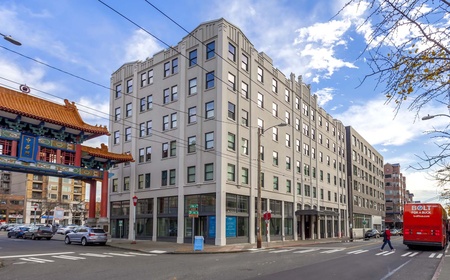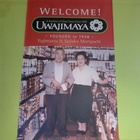Uwajimaya, which has been run by the Moriguchi family, who have their roots in Ehime Prefecture in Shikoku, took a new step last year when Dennis Moriguchi, grandson of the company's founder, Fujimatsu Moriguchi, became CEO.
Uwajimaya has previously operated four stores, including the Seattle store, but last spring it opened a store called "Kai Market" in an office building in the South Lake Union district, about three kilometers north of Seattle city center.
Also last spring, Uwajimaya opened a six-story commercial and residential complex called Publix next to its Seattle store in the International District, strengthening Uwajimaya's presence in the area.
Uwajimaya continues to grow, but let's take a quick look back at its history in America.
From truck peddling to village construction
Fujimatsu Moriguchi was born in 1898 (Meiji 31) in Kawakami Village, Nishiuwa County (present-day Kawakami Town, Yawatahama City) in the southwestern part of Ehime Prefecture. He left his hometown and came to America in 1923 (Taisho 12) at the age of 24.
After working on a farm, he worked at a restaurant in Tacoma, about 50 kilometers south of Seattle, and then started working at Maine Fish Company, a fresh fish company run by a Japanese in Seattle.
At that time, Seattle had a Japantown formed by Japanese immigrants, and there were many businesses selling rice, miso, soy sauce, etc. to Japanese people working in the fishing, farming, railroad, and lumber industries in the area. Fujimatsu worked at one of these companies and learned how to handle fish and do business there, and decided to start a similar business in Tacoma. In particular, he thought about making and selling kamaboko and satsumaage, which he had learned in Japan.
Like Seattle, Tacoma, a city on the Pacific coast, had shipping services to Japan, and in 1909 Osaka Shosen opened a regular route from Tacoma. A consulate was also established (later relocated to Seattle), and Japanese people began working in a variety of fields, including fisheries, agriculture, railroads, and commerce, leading to an increase in demand for Japanese ingredients and food.
After returning to Tacoma, Fujimatsu opened Uwajimaya in 1928, named after the town of Uwajima in Ehime where he had trained. He made kamaboko and other products, loaded them onto trucks and sold them to nearby Japanese customers.
In 1933, Fujimatsu married Seattle-born Tsutakawa Sadako, and four years later, they opened a new store in Tacoma's Japanese town and continued their business. However, the economy slumped in the 1930s. Furthermore, when the Pacific War began, he, like other Japanese Americans, was sent to an internment camp at Tule Lake in northern California. At the time, the couple had four children.
They had three more children after that, and after the war they moved with their family to Seattle and opened a new store, Uwajimaya, in the old Japantown. They continued to do business with Japanese-American and Japanese customers, but a turning point came in 1962. That year they opened a store at the World's Fair held in Seattle and sold a variety of products, including gifts from Japan, which led to Uwajimaya becoming widely known among people other than Japanese-Americans, which led to its subsequent growth.
Fujimatsu also passed away that year, but his children took over the business and in 1965 incorporated it, expanding into wholesale as well as retail. Fujimatsu's second son, Tomio Moriguchi, led the company and demonstrated his talent as a manager for many years. In 1970, the store moved to the area near the current Uwajimaya store, and it became the largest Japanese supermarket in the Pacific Northwest.
After that, the store expanded further to include crafts, books, clothing, cosmetics, tableware, etc. In 1978, the Bellevue store was opened, which became a foothold for further store expansion.
In 2000, they moved the new store to the immediate vicinity of the existing store, and began construction of Uwajimaya Village, which would house the tenants and other businesses. In 2002, Sadako passed away, and a few years later the Village was completed and the business steadily expanded. In 2007, Tomoko Matsuno, Tomio Moriguchi's sister, served as CEO until last year, when she handed the reins over to the current CEO, Dennis Moriguchi.
The business, which began as Fujimatsu's peddling business from a truck, expanded to include wholesale, food services and real estate, with retail as its core business, and has grown into the Uwajimaya of today, a consistent family-run business.
(Titles omitted)
© 2018 Ryusuke Kawai







